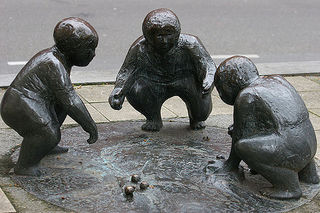Play Is Serious Business

Source: Kristina Fenske
This guest post was written by Kristina Fenske, a post-baccalaureate researcher at the University of Southern California.
I cringe when I hear the words, “You are going to miss recess if you don’t finish your work!” My heart aches a little more when a seven year old child sighs and says, “Now I have homework for school and for my after school program.” When did learning become work? And why should play be a privilege? It is ironic that the rigorous push toward academia has crowded out play, since play is how we evolved to learn. Virtually all baby animals play – we’ve all seen puppies chase sticks or kittens wrestle with yarn, but did you know that an octopus will go nuts over a stack of Legos? For human children, play isn’t just a frivolous activity; it helps kids create social relationships and practice for adulthood. Through play, children experiment with different possibilities and take on different roles, learn how to get along with others, build physical and mental skills, and develop self- . Play is serious business. So why is it so often treated as an afterthought by educators?
Peter Gray, a developmental psychologist, writes extensively about the history of school structure in his book, Free to Learn. Formal schools emerged after the shift from hunter-gatherer culture into an agricultural society. Agriculture required that humans know how to follow directions and plan ahead in order to farm productively. Later on, the Prussian military developed a model that now resembles our school structure today, focused on the tasks of disciplining children and molding them into followers. Many schools today differ only slightly from their Prussian predecessors. In the traditional school classroom, children sit for long hours and listen to instructions with little breaks. Their interests are everywhere but the teacher. Researchers have already exposed the risks of sitting for hours at a time and know that it increases problems and the risk for cardiac diseases, diabetes, and . Children with more sedentary lifestyles are at significantly higher cardiovascular risk. Our bodies tell us that we need to move, be active, and play. It takes a great teacher to adapt the classroom curriculum into a fun, creative, and engaging experience using movement to learn. It isn’t easy to do. However, play is instinctual and built into our biology.

Source: cea+, Creative Commons license
Stuart Brown, one of the foremost play researchers in the world, states that play is essential for both development and social development, from into adulthood. It is a biological mechanism for making learning enjoyable. Most of our fondest involve play because of its emotional connotations. As Mary Helen Immordino-Yang, Assistant Professor of at USC Rossier School of Education and of Psychology at USC Brain and Institute, has written, it is “literally neurobiologically impossible to build memories, engage complex thoughts, or make meaningful decisions without emotion.” Play helps meld emotion into the experience of learning.
Despite evidence supporting the importance of play in learning, many schools have moved in the opposite direction and limited open playtime. Some schools have gone as far as to eliminate recess entirely. The rise of high-stakes testing and a push for schools to become more academically oriented has not only ousted play, but reduced kids’ access to other “playful” outlets like gym, music, and art classes. So how does lack of play affect children’s levels? If a child is denied the opportunity to play, the body and mind fight back. “Play deprived” children may show signs of anxiety, , attention problems, and difficulty with . Play allows children to let off steam. Play can also be joyful, and, as University of North Carolina researcher Barb Fredrickson has found, positive emotions broaden the scope of attention and increase flexibility. Why not embrace the tool in the curriculum?
I asked a mother of three young children her thoughts about play in school for her children. She had purposefully enrolled them in schools that allowed more time to play. After seeing her children receive the play that is needed in schools she states that, “ It helps me with stress because if I know they’re getting the time they need at school to play. Also, I think it also makes the kids feel less anxious if they feel like learning is fun rather that just a constant vying for approval from the teacher. It’s a fun for them to be in. When I was a kid, I felt the pressure to get that ‘A’ in class. It puts a lot of stress on them and me. I don’t want that to be the only goal for my kids.”

Source: Praveen Kumar, Creative Commons license
When school becomes a stressful place for a child, it is no longer a supportive, positive learning environment. Play at schools help children build social relationships, solve problems, connect bridges and deal with tough situations. Some schools actively embrace play, like Sudbury Valley School in Massachusetts or many Montessori-model schools. And many brilliant teachers at traditional schools can adapt their classrooms to include more choices, more creativity, and more open play. In the 1980s, the editor of this blog, Darby Saxbe, attended the Open Room, a progressive multi-age classroom within the Oberlin public schools in Oberlin, OH. Students rotated between stations or centers devoted to different activities, from an art area to a reading loft with pillows and a selection of books. The emphasis was on self-directed activities that fostered student responsibility, rather than a one-size-fits-all model of whole-class instruction. Sadly, the Open Room was scaled down and then finally closed by the school district in 2010. Play has become a luxury – available in private schools that espouse progressive learning principles, but crowded out of public schools by a teach-to-the-test mentality. More Open Rooms are needed in public schools to help nurture all kids’ of learning.
Despite increasing research on play and emotion, relatively few studies of play within the school environment exist. and educators can advocate for play and push for more time and space for children to engage in open-ended play – not as an alternative to learning time, but a core part of the learning experience itself. Increasingly, educators are calling for a return to the greater integration of play into elementary education. Rather than view play as a “privilege,” educators can reframe it as one of the best tools for engaging children and fostering their excitement about learning.
Kristina Fenske Is a graduate from University of California, Los Angeles and University of College London. She works as a DIR/ Floortime Specialist, a Research Assistant at NEST Laboratory at USC, and is an Instructional Assistant at a Elementary School. She also volunteers at the Children’s Hospital Los Angeles. Her main research interests are in play, and social skills building within the field of psychology and occupational sciences.
References
Brown, S. L., & Vaughan, C. C. (2009). Play: How it shapes the brain, opens the imagination, and invigorates the soul. New York: Avery.
Courage, K. H. (2014, November 18). Octopus Play and Squid Eyeballs—and What They Can Teach Us about Brains. Retrieved August 15, 2016, from http://blogs.scientificamerican.com/octopus-chronicles/octopus-play-and-…
Fredrickson, B. L. (2001). The role of positive emotions in : The broaden-and-build theory of positive emotions. American Psychologist, 56(3), 218.
Gray, P. (2013). Free to learn: Why unleashing the instinct to play will make our children happier, more self-reliant, and better students for life. New York, NY: Basic Books.
Immordino-Yang, M. H. (2016, May 31). Why Emotions Are Integral to Learning. Retrieved June 12, 2016, from http://ww2.kqed.org/mindshift/2016/05/31/why-emotions-are-integral-to-le…
Katzmarzyk, P. T. (2014). Standing and Mortality in a Prospective Cohort of Canadian Adults. Medicine & Science in & Exercise, 46(5), 940-946. doi:10.1249/mss.0000000000000198
Mcmanus, A. M., Ainslie, P. N., Green, D. J., Simair, R. G., Smith, K., & Lewis, N. (2015). Impact of prolonged sitting on vascular function in young girls. Exp Physiol Experimental Physiology, 100(11), 1379-1387. doi:10.1113/ep085355
Miller, E., & Almon, J. (2009). Crisis in the Kindergarten: Why Children Need to Play in School. College Park, MD: Alliance For Childhood. Retrieved August 14, 2016, from http://www.imaginationplayground.com/images/content/2/9/2963/crisis-in-k…
Zielinski, S. (2015, February 20). Five surprising animals that play. Retrieved August 12, 2016, from https://www.sciencenews.org/blog/wild-things/five-surprising-animals-play















![Toni Kroos là ai? [ sự thật về tiểu sử đầy đủ Toni Kroos ]](https://evbn.org/wp-content/uploads/New-Project-6635-1671934592.jpg)


